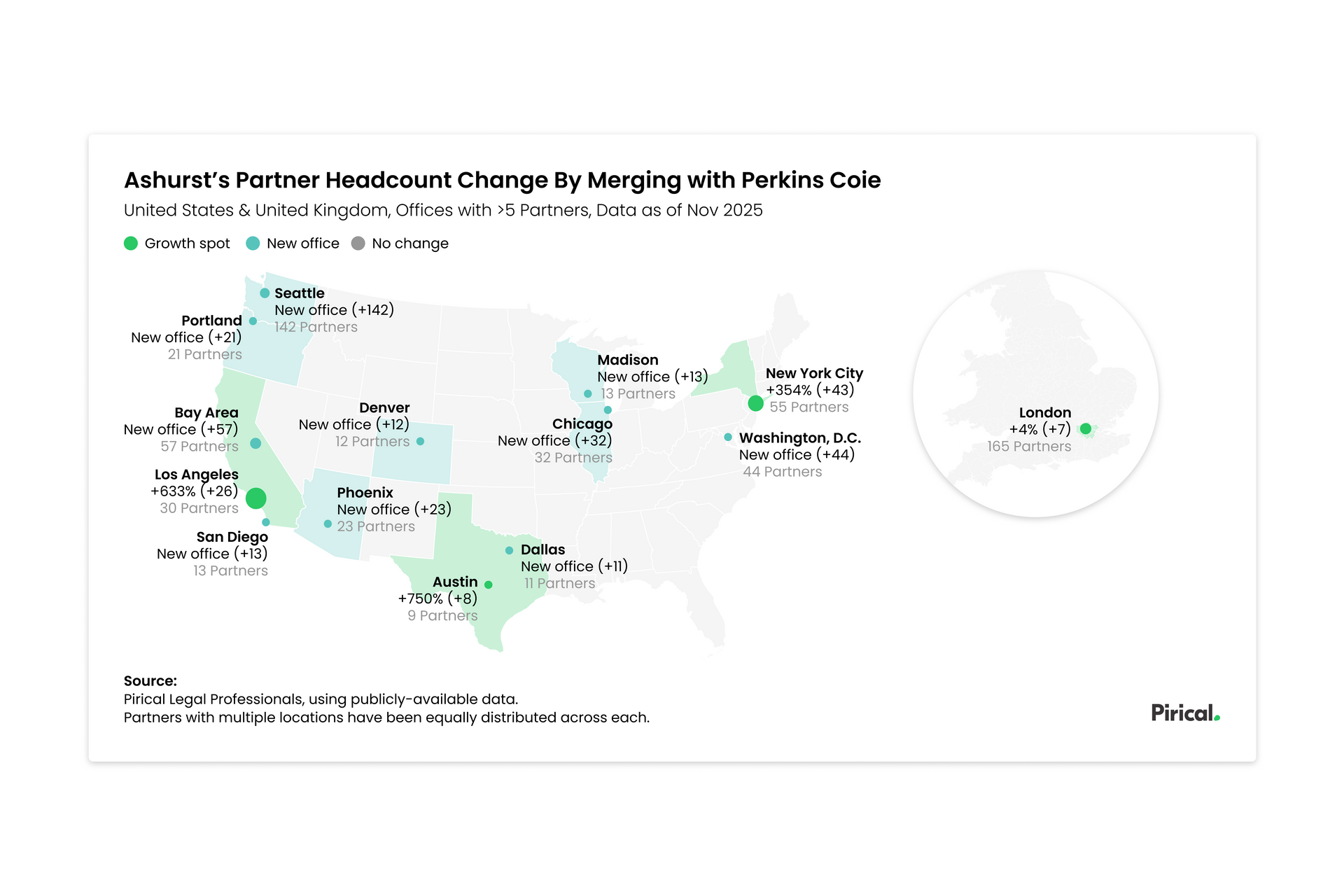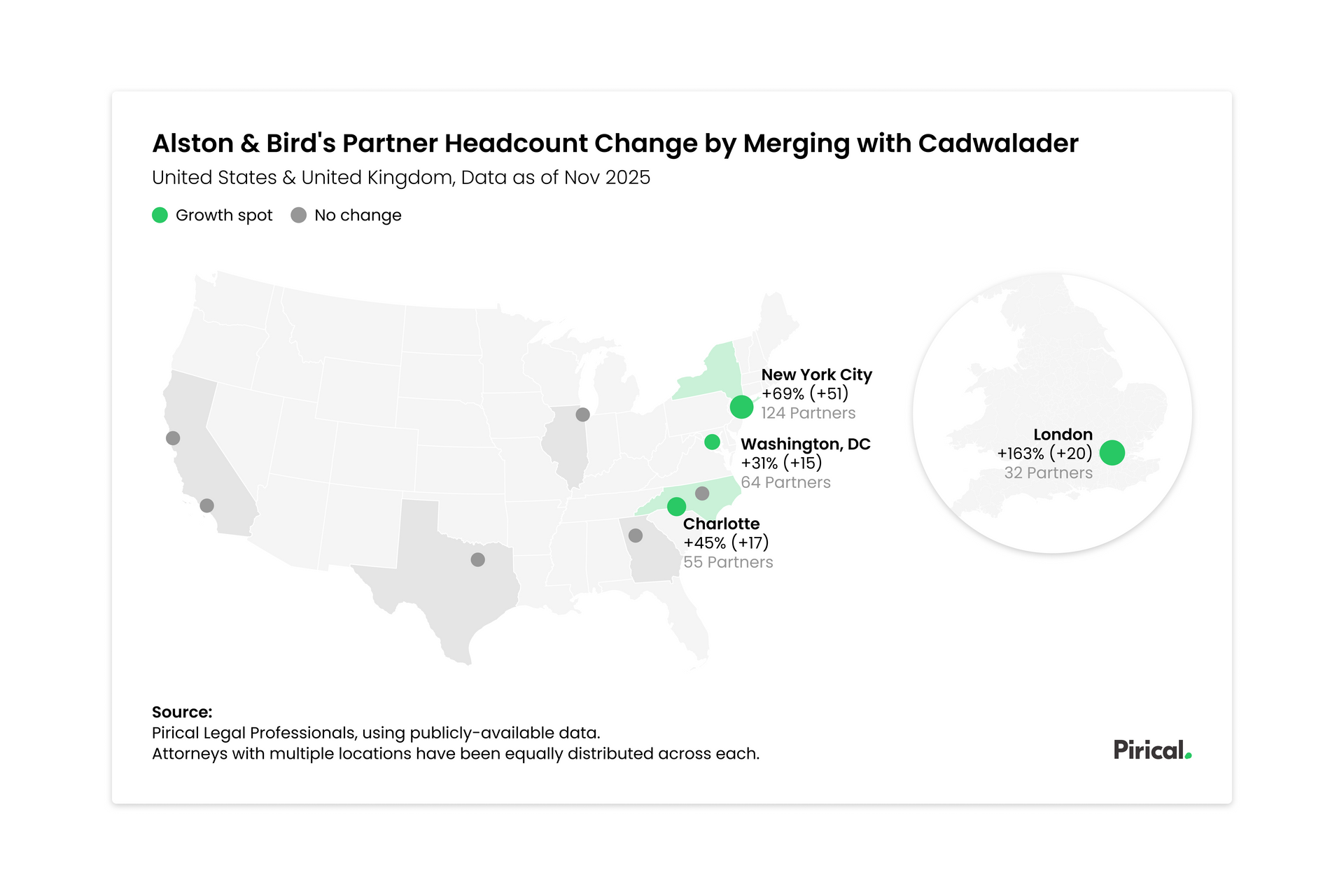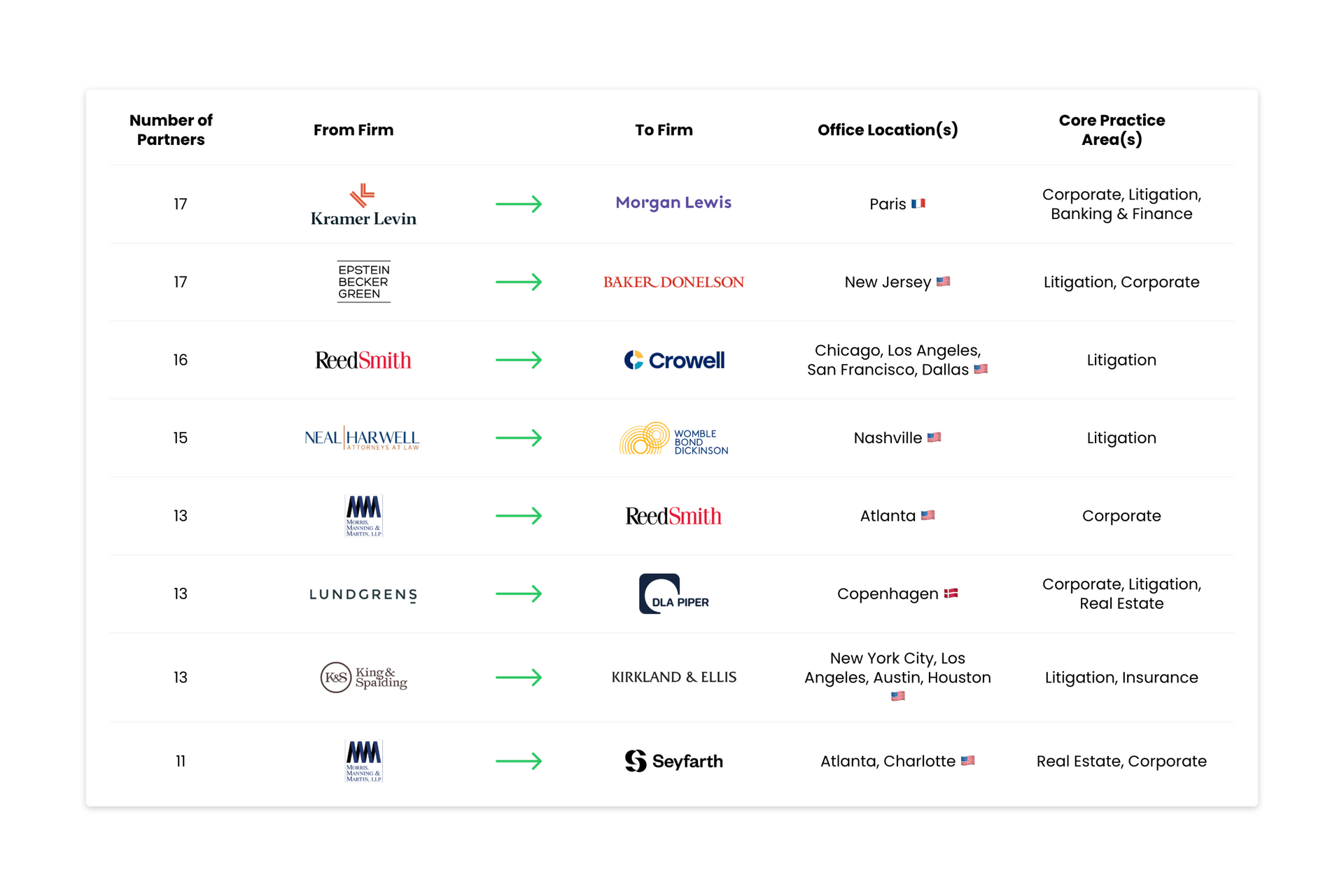Ethnic diversity at top UK law firms
The diversity discount: an idea whose time has come?
Despite years of public statements, monitoring programmes, and much else besides, there has been scant evidence to this point that major companies would ever penalise or walk away from legal services providers on the basis of poor diversity.
What if 2020 was the year that changed?
A small stream of companies have started to change the terms of engagement with legal providers, and are putting real money on the line for diversity:
“HP Inc.’s chief legal officer and general counsel, Kim Rivera, warned law firm partners in a recent letter that U.S. firms could see 10 percent of their fees withheld if they fall short of the company’s diversity requirements.”
— 15 February 2017 / Bloomberg
“Novartis has agreed diversity and inclusion targets with its new roster of preferred global and US law firm advisers and will withhold 15% of their fees if they are not met.”
— 13 February 2020 / Global Legal Post
“Telecoms giant BT has come up with a novel way to encourage its panel law firms to be more diverse [...]: a guaranteed renewal for the firm with the best diversity and inclusion record.”
— 27 April 2020 / Law Gazette
The impact? Law firms are doubling down on diversity.
What we’re seeing is that the prospect of losing (now quantifiable) revenue for being too white and male has ignited a new wave of activity. Diversity can no longer be the domain of a single department or working group. The whole partnership has a stake in knowing how they’re doing compared to the sector, and drawing up detailed plans of how to improve.
While some law firms have already been taking serious action on ethnic diversity in recent years, others are more recently embarking on their journey, encouraged by a clear direction of travel in social attitudes and public policy.
Our UK clients in particular are anticipating the introduction of something similar to the mandatory gender pay gap reporting, but instead about ethnicity.
In this article we introduce the emerging best practices around diversity analytics, and share our view of what the real pioneers are doing: which is going beyond lip service and opening up their HR data to clients directly, demonstrating a deeper commitment to their diversity agenda.
The fastest improving firms have grown their share of BAME fee earners by 5% in recent years. How?
The firms competing to win have been approaching their diversity strategy in three distinct phases:
- Sector Benchmarking. The entry-level activity. The objective: to get a comprehensive understanding of what good looks like.
- Detailed Introspection. The next step. Only for the brave. Take stock of your own performance and practices. Uncover the difficult truths. Identify the priority areas for change and set meaningful targets.
- Client-specific Reporting. The emerging frontier of diversity analytics. How can firms and clients work together to improve diversity? For each client, how representative is the service they receive? And how do they influence the firm’s diversity and culture, for better or worse?
Phase 1 - Sector Benchmarking: You can’t fix what you can’t see
Benchmarking is the best first step for most firms.
The objective is to understand where you currently are, what you’ve done well, what you need to work on, contextualised with what good looks like in your peer group and which challenges are shared across the sector.
Some of the most important questions to ask are:
- How does ethnic diversity vary with seniority at our firm? And how do we compare to the market average?
- Is our recruitment - both at graduate level and among lateral hires - helping or hindering our diversity ambitions?
- Are we retaining BAME trainees, particularly at NQ level, and losing BAME employees through attrition equally compared to White colleagues?
- Are our promotion rates fair, particularly to the partnership?
- How does the experience vary by the constituent demographic populations (e.g. Black, Asian, Mixed Ethnicity)?
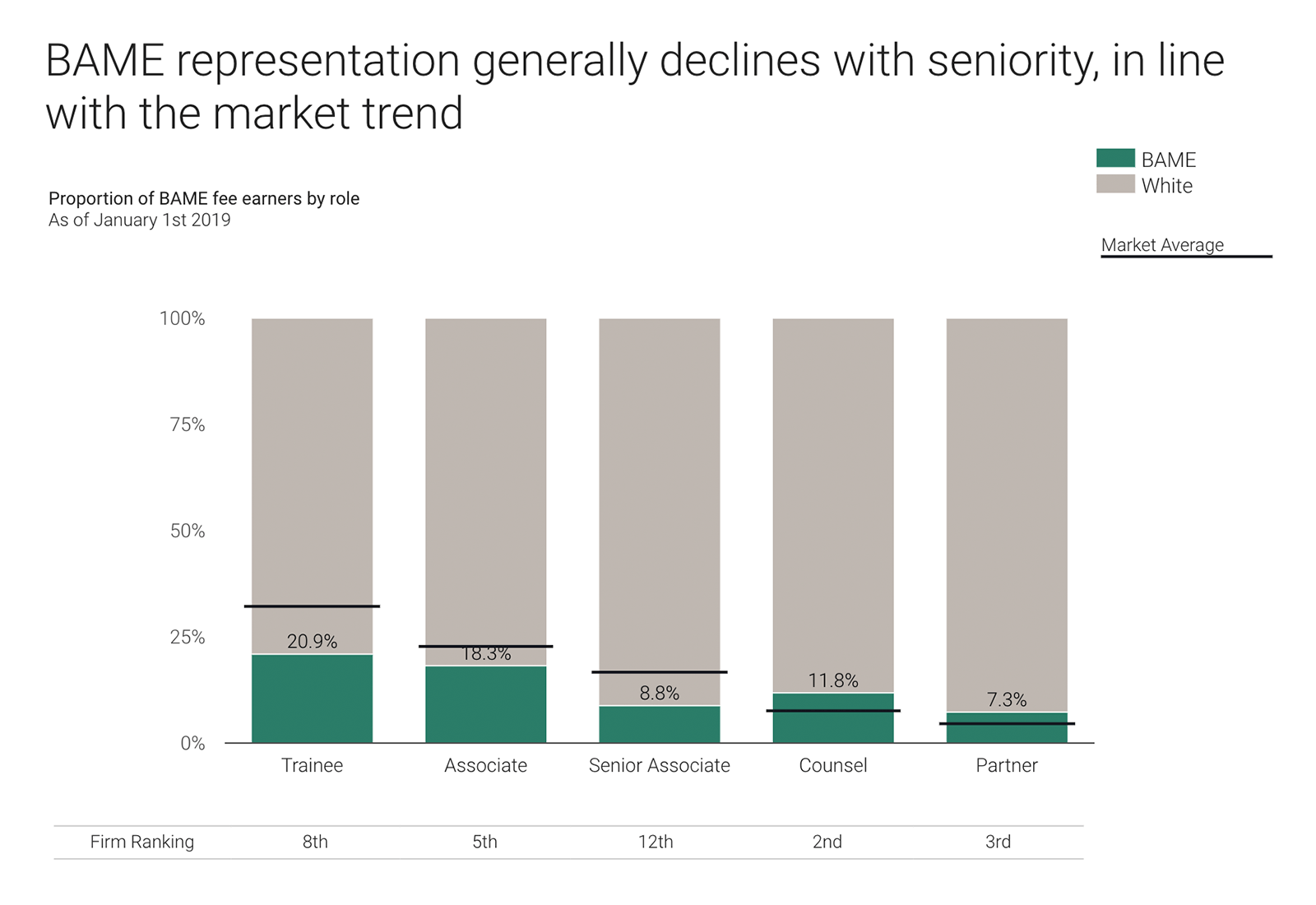
‘BAME representation generally declines with seniority, in line with the market trend’. Fictional data for illustration only.
Ethnicity data collection can be a real challenge, often restricted if not by a firm’s own policies and culture, then by regulation.
In the UK, unlike - for example - France, we are lucky to have a supportive legal framework that allows employers to collect and process ethnicity data.
For many firms just being able to participate in benchmarking is the real breakthrough.
See which firms are participating in our BAME Benchmark exercise
The ‘Sir Roger Bannister’ Effect
For each of our analyses we include the data point for ‘Best Performing Firm’. See image below.
We think showing people what’s been achieved so far is an important part of lifting ambitions for the sector overall.
Too often we are faced with apathy about what’s possible and what’s within the control of a law firm. Senior leaders may blame the education system, the hiring market or the culture across the legal sector. We want to make it impossible to drag your feet and mutter ‘everyone has this problem’.
So we make sure to highlight ‘the score to beat’.
Nobody thought running a 4-minute mile was possible, until they saw Sir Roger do it.
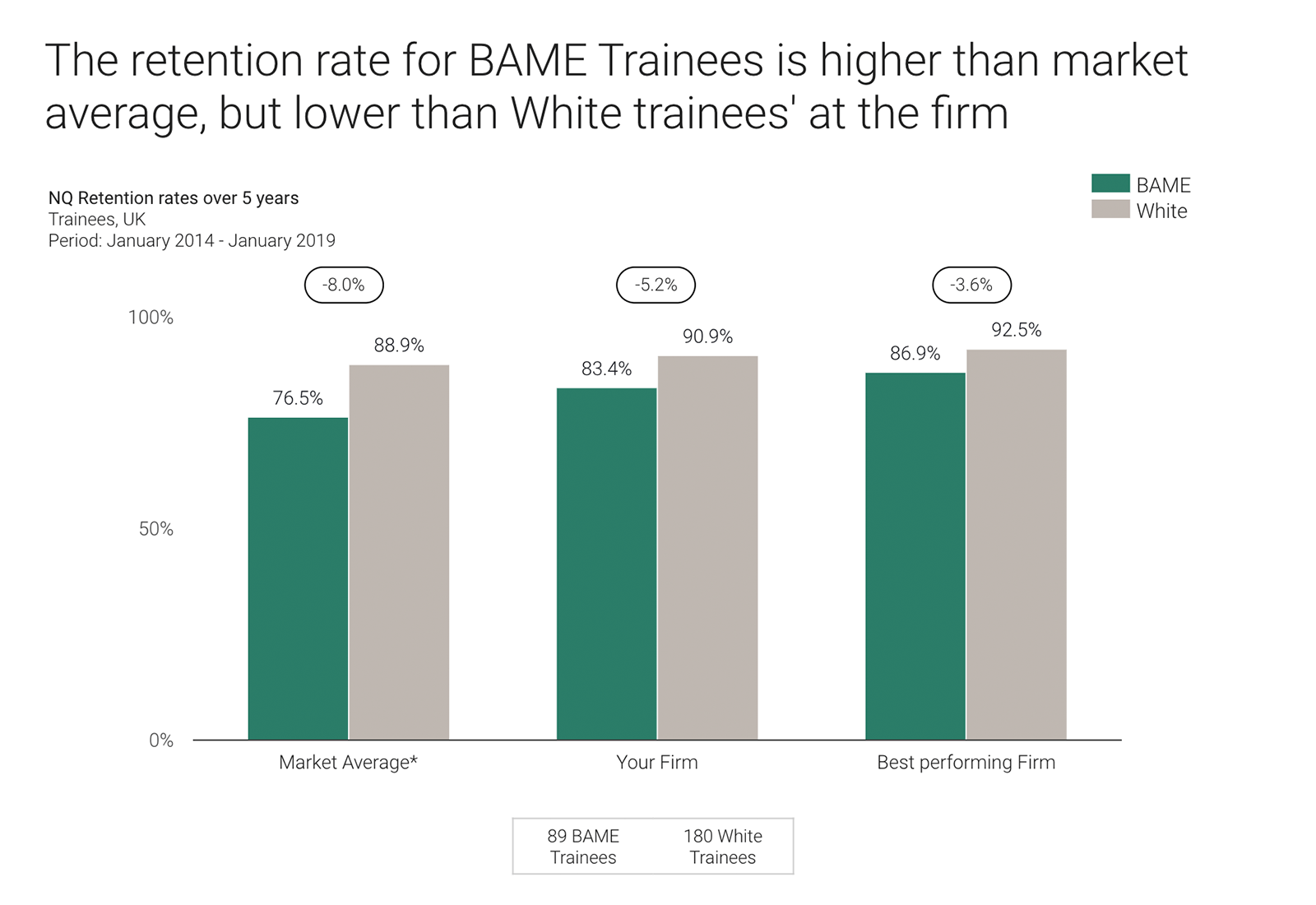
‘The retention rate for BAME trainees is higher than market average, but lower than White trainees' at the firm.’ Fictional data for illustration only.
Phase 2 - Detailed Introspection:
After benchmarking, many firms go for a more granular assessment of their own performance.
This will typically dive into some detail to explore differences by practice areas, by geography, or by team.
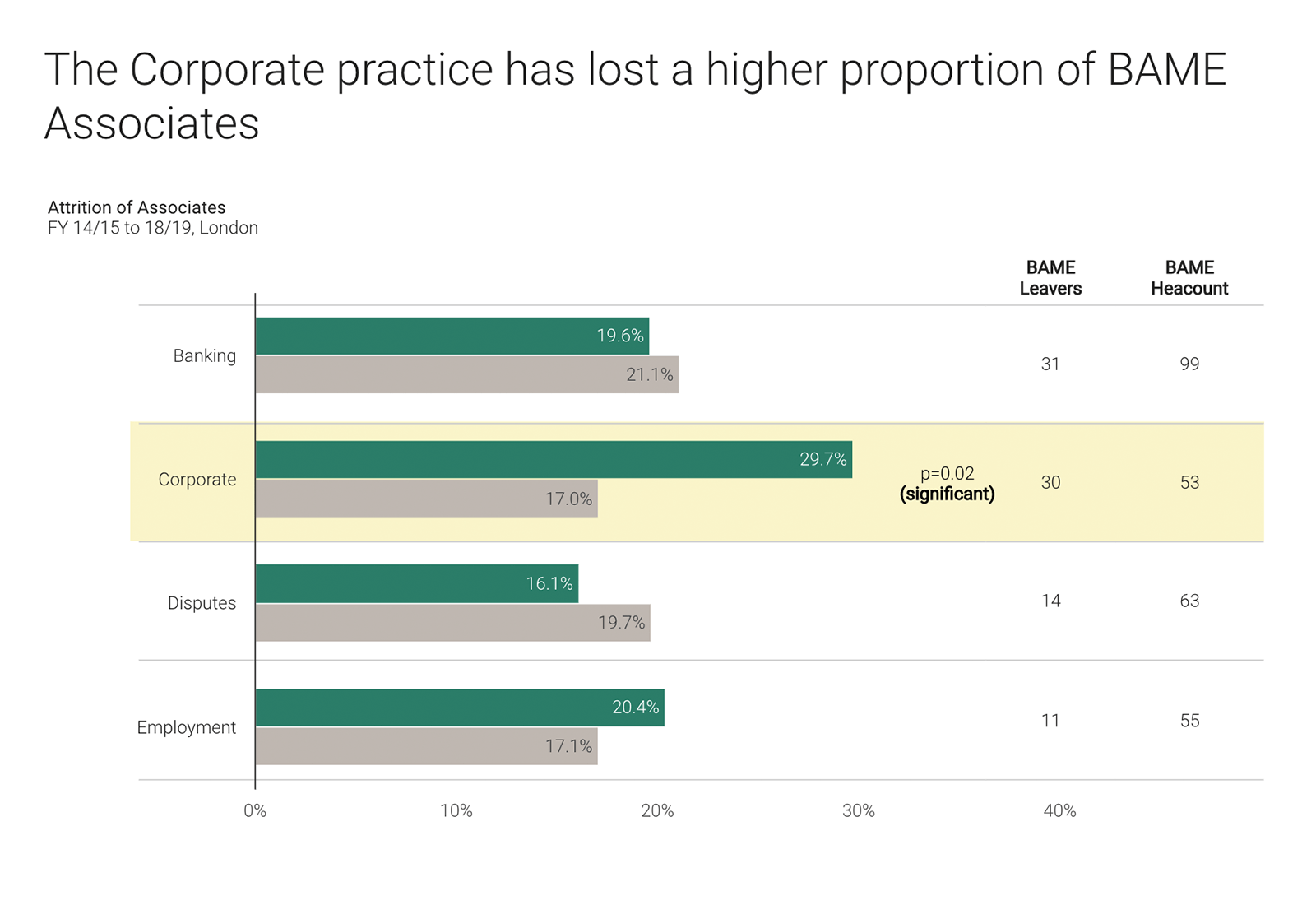
‘The Corporate practice has lost a higher proportion of BAME Associates’. Fictional data for illustration only.
Examples of some of the more detailed analyses that can be done at this stage include:
- How does the experience of Fee earners compare with Business Services staff?
- Which areas are most/least attractive to junior BAME colleagues?
- Do BAME employees attend training at the same rate?
- Which of the firm’s recruitment channels and practices are best for attracting diverse groups?
- How do intersectional individuals experience barriers in the firm? In particular how do gender and social class interact with ethnicity?
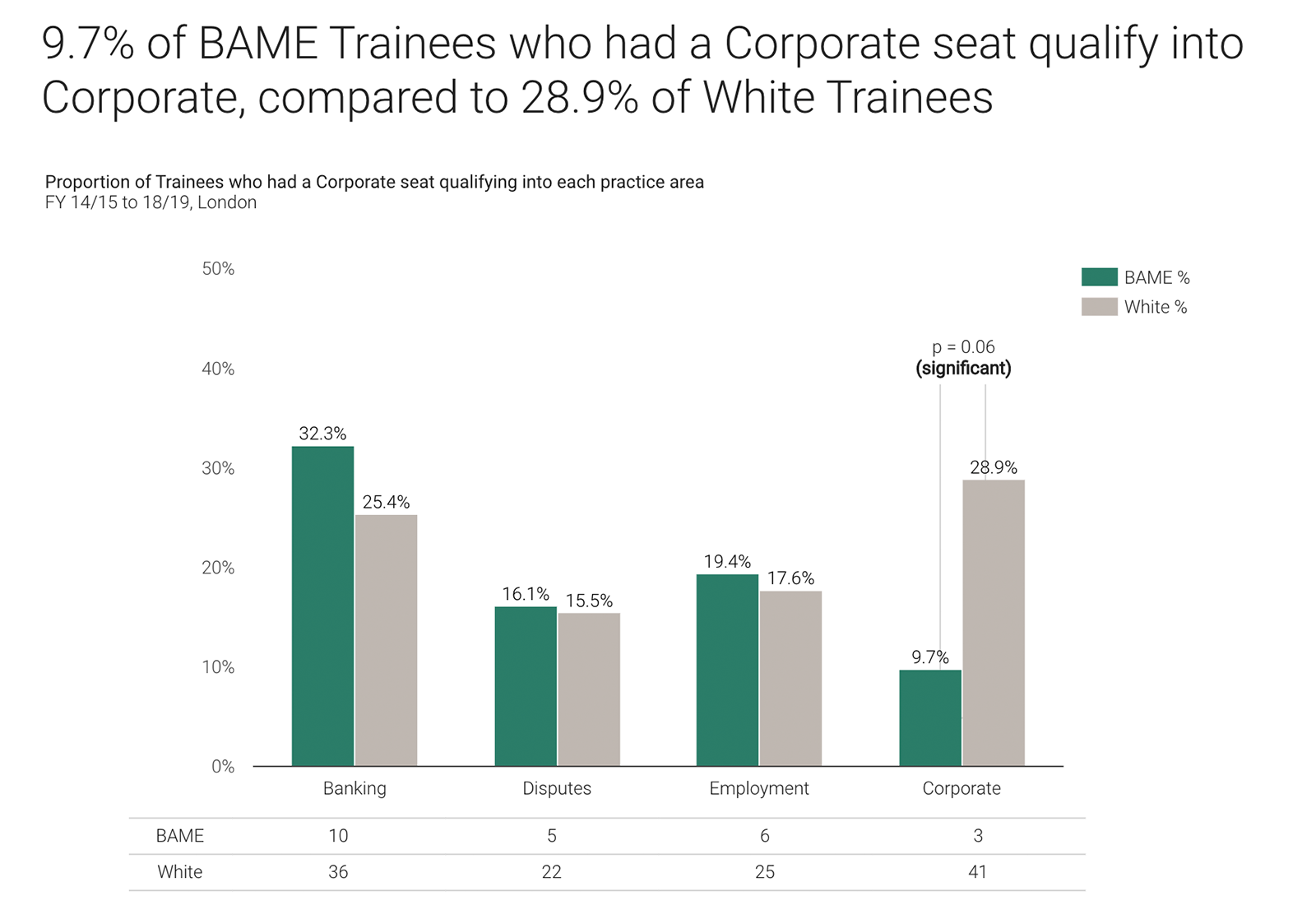
‘9.7% of BAME trainees who had a Corporate seat qualify into Corporate, compared to 28.9% of White trainees’. Fictional data for illustration only.
Detailed Introspection is a great way of providing a focus to qualitative research, or an objective baseline to inform a wider review. A lot of our clients use diversity analytics this way.
Headcount is only part of the story
While investigating ins and outs is a great jumping-off point, focusing too much on it can distract from a number of other challenges related to tokenism and equality of opportunity.
Using a blend of HR, finance and matters data, law firms can identify common issues including:
- Employees from minority ethnicities working fewer billable hours or a different balance of billable hours vs. investment hours
- Different spread of opportunities to be client-facing
- Unequal allocation of high-value or high-prestige matters. See image below.
- Write offs and discounts falling disproportionately
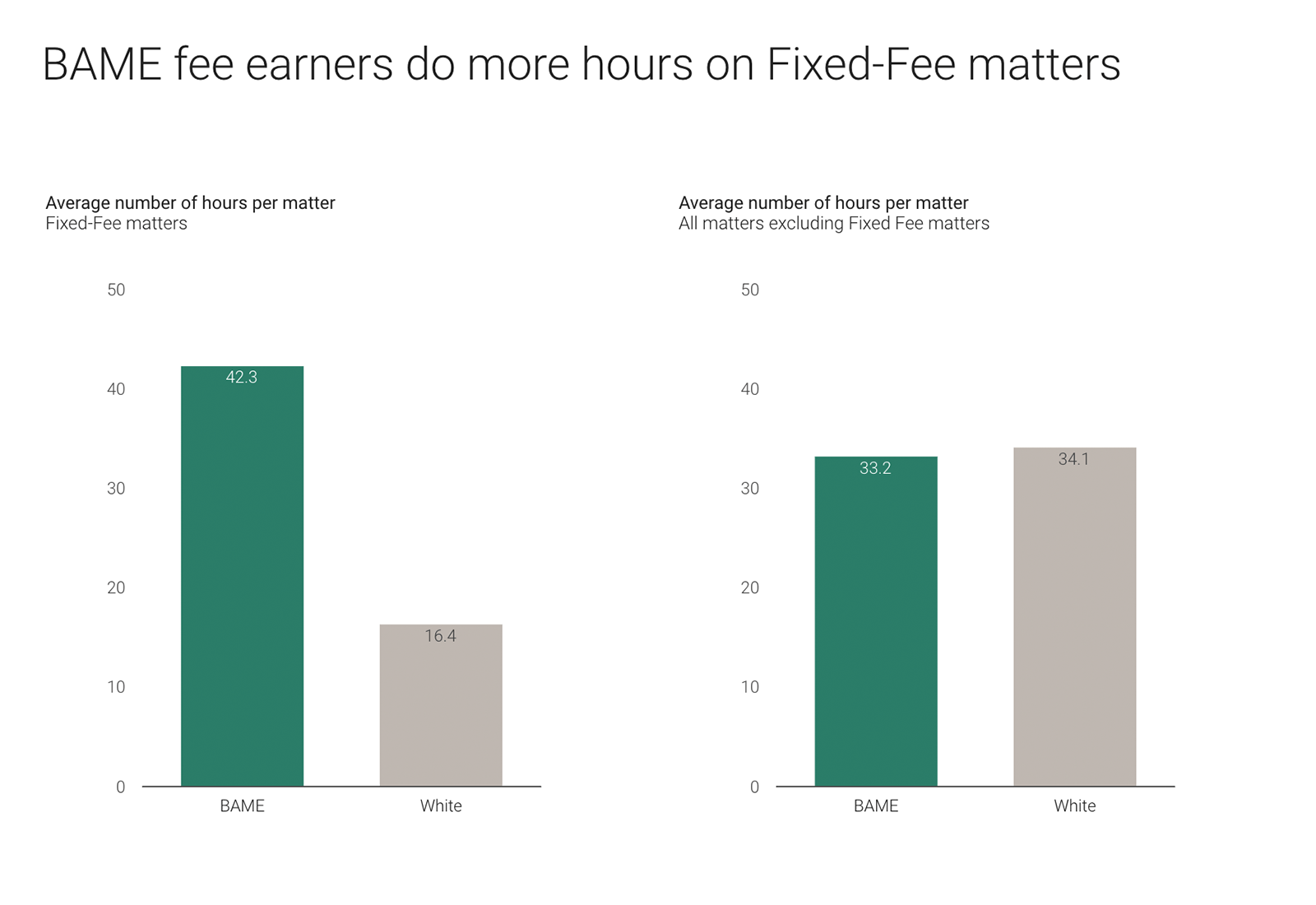
‘BAME fee earners do more hours on Fixed-Fee matters.’ Fictional data for illustration only.
Phase 3 - Client-specific Reporting:
The real pioneers of ethnicity diversity reporting are now producing tailored reports for each of their major clients.
While the firm’s motivation is typically to demonstrate a higher level of commitment to diversity than competitors, best practice is to keep the reporting as objective and authentic as possible.
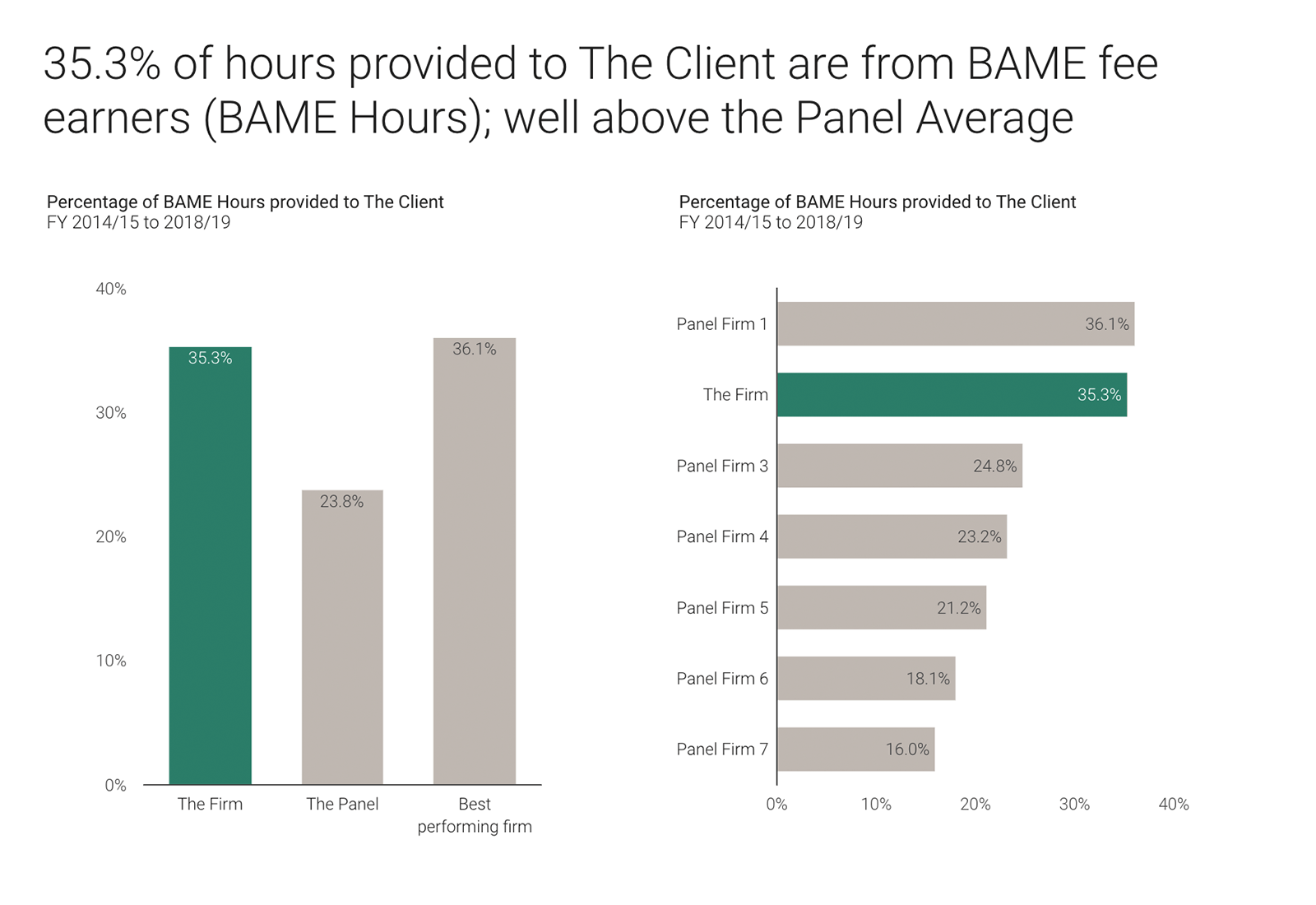
‘35.3% of hours provided to The Client are from BAME fee earners (BAME Hours); well above the Panel Average’. Fictional data for illustration only.
Not all analyses will shine a relentlessly positive light on the firm. Some are likely to highlight areas for action.
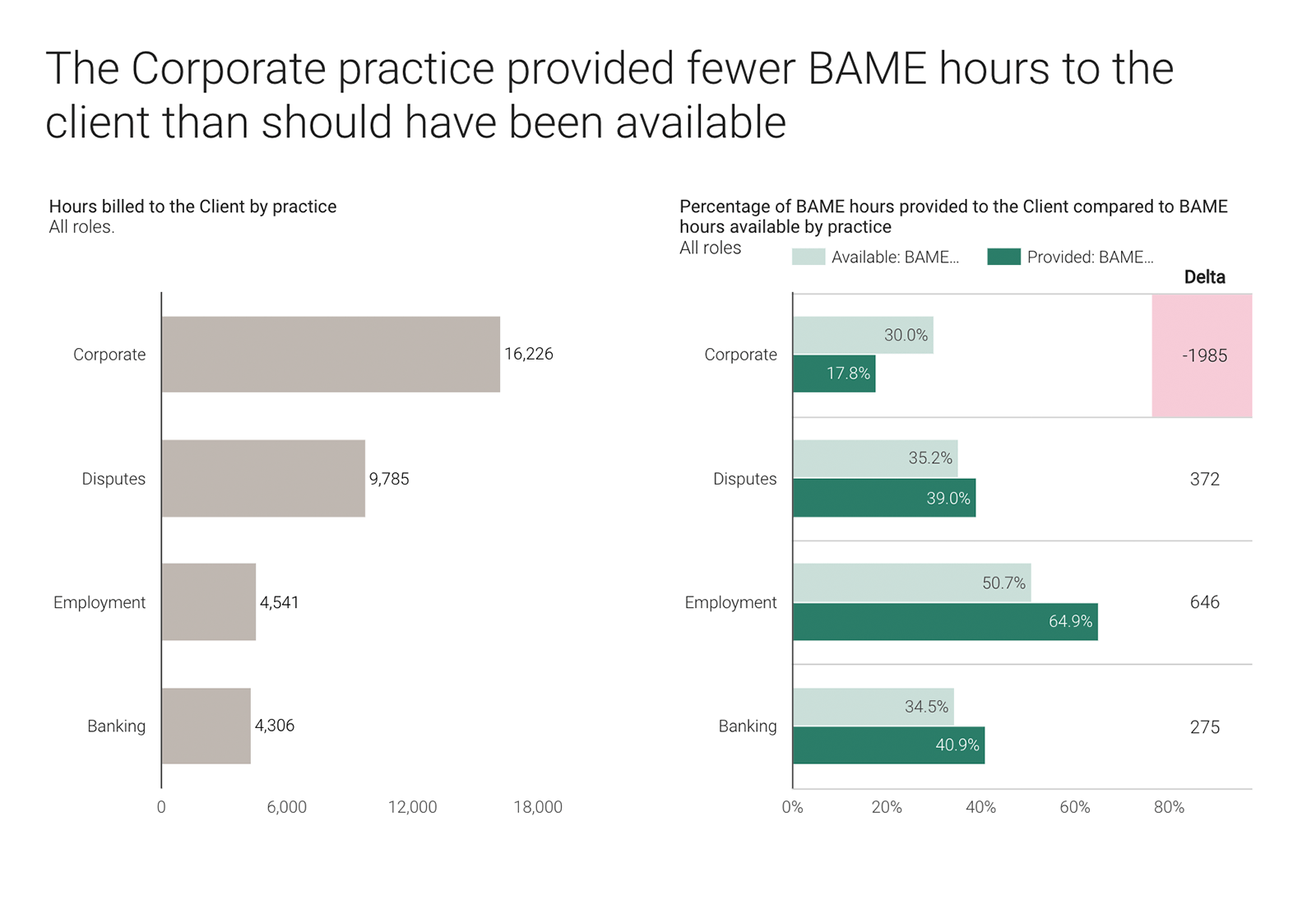
‘‘The Corporate practice provided fewer BAME Hours to the client than should have been available.’ Fictional data for illustration only.
But it shouldn't be considered a one-way street. Law firms have deep and long-standing partnerships with their clients. People and ideas are a revolving door. Clients influence culture as much as anything else.
Client-specific reporting is about finding ways that the firm and the client can work together, to make shared progress and to strengthen their partnership in future.
Conclusion
We are increasingly prepared to talk about ethnic diversity - and the challenges around it - frankly, openly and in a professional context.
Since 2015 Pirical has been working with legal and professional services firms to introduce decisions based on data instead of those driven by hunches, opinions, and old ideas.
We have helped dozens of clients to kick-off major culture change projects, to retire counterproductive practices and programmes, to set smart but ambitious targets, and to form bold cross-sector collaborations at the most senior levels.
With our help, top law firms are identifying the good, the bad, and the opportunity by analysing diversity in three phases:
- Sector Benchmarking
- Detailed Introspection
- Client-specific Reporting
While each unlocks a deeper level of insight than the previous, it also demands higher levels of bravery, trust and commitment.
You may be interested to know the next round of BAME Benchmark is due to start soon.
To learn more about what many consider to be the most significant diversity initiative happening right now in the legal sector please see the BAME Benchmark page or contact us directly.
We’re used to helping clients at the start of their journey, and can provide advice about data collection and management too.
Subscribe to the latest data insights & blog updates
Fresh, original content for Law Firms and Legal Recruiters interested in data, diversity & inclusion, legal market insights, recruitment, and legal practice management.



